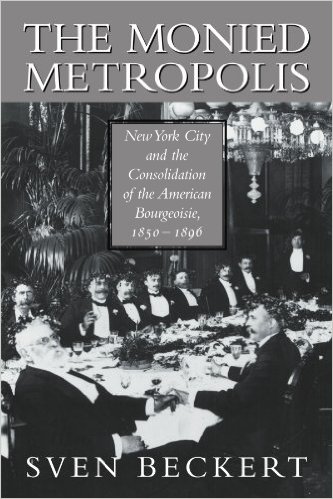
Sven Beckert began his novel with a description of the Bradley Martin Ball at New York’s Waldorf Astoria Hotel on February 10th, 1897. Despite it being during the worst economic depression experienced in the nineteenth century, 700 of New York City’s economic elite, the merchants, industrialists, bankers, and professionals, came dressed in historic outfits of European aristocracy that were seemingly just as ostentatious and expensive as the original European aristocracy themselves. John Jacob Astor came dressed as Henry of Navarre and held a sword decorated with jewels. There were nearly fifty impersonators of Marie Antoinette, with hostess Cornelia Martin wearing a necklace previously owned by Marie Antoinette herself. A lot of New Yorkers objected this kind of behavior, especially in the midst of a crisis, so the Martin’s defended their guests against these lower classes by employing New York’s police, Pinkerton detectives, and closing the first-floor windows. In general, the ball wreaked a stench of gaudiness and exclusion that heavily contrasted with the economic elite of the antebellum era.
In many ways, the Bradley Martin Ball was the quintessential representation of Sven Beckert’s argument. The majority of The Monied Metropolis explains how this came to fruition. Beckert asserts that New York’s bourgeoisie (which he classifies as the upper class and economic elite that derived their status from the ownership of wealth rather than birthright, status, or kinship) had “articulated a consciousness of separate class identity” by the 1870s and 1880s that was not present before. The elite class before the Civil War consisted mainly of merchants that believed in a “socially cohesive society without deep class divisions” whereas after the Civil War, the bourgeoisie, composed of industrialists and bankers coalesced into a distinct, self-conscious elite.
Beckert ultimately has a strong argument about the contingency of the collective bourgeois formation in relation to the main events of the late 19th century, such as the Civil War and the depression of 1873, and in relation to proletarianization. The connections he makes between these events and the bourgeois class formation are fairly plausible, especially since he always acknowledges the naysayers. For example, Beckert discusses how the bourgeois began to consolidate over their agreement to mobilize for war on the South in 1861. Beckert acknowledges that it would have seemed more likely they would have called for compromise and accommodation. Secession was the worst situation possible for the upper-class power since the passage of tariff by the Confederate prevented the possibility of maintaining trade relations with the South. This tariff also would have threatened the stability of the United States’ monetary system since it was backed up by the Bank of England, which heavily relied on the export of agricultural commodities from the South. Even though the city’s economic elite had a plethora of reasons to prevent secession, Beckert was able to strongly show how the factors leading to mobilization were so influential that it forced even the most reluctant elites to change their stance. It also helps Beckert illustrate how breaking away from the South ultimately facilitated revolutionary changes for the economic elite.
Beckert also does a great job illustrating the intersectionality between seemingly independent events. As mentioned before, proletarianization was contingent mainly in relation to the Civil War, the emancipation of slaves, and the depression of 1873. Beckert’s explanation of the depression of 1873 will be the example used, given that it is his most persuasive argument and the most integral to the formation of the stratified class structure known about the Gilded Age today. Beckert writes that the depression ultimately sharpened social conflicts because it forced the city’s economic elite to enact entrenchment practices. Around 25 percent of all New York City workers were let go from their jobs. Even those who maintained their jobs suffered due to wage declines. Ultimately, these workers gathered to protest in order to acquire relief (7,000 unemployed workers gathered in Tompkins Square Park), such as they did during the 1857 crisis, but these protests ultimately left the economic elite more anxious about the proletariat take over. Although the depression may seem like it stalled economic growth and therefore the rise of the bourgeois, Beckert inventively includes the factor of proletarianization to prove how the depression actually consolidated the elite.
Beckert’s extensive historical sources and his innovative and detailed analysis of the Gilded Age, this book could be recommended to anyone with an interest in class analysis and 19th century United States history. It is definitely for a more academically-oriented audience given that Beckert writes for an audience with extensive prior knowledge on class analysis and 19th century United States history (he never defines proletarianization). Nevertheless, those that can decode the disciplinary vocabulary will find an interesting story of class conflict in an era often considered complacently stratified.
Reviewed by: Demetrios Giannios
